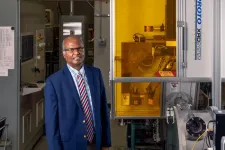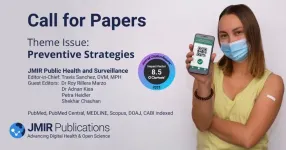(Press-News.org) The U.S. Department of Energy recently announced a $10 million investment in three projects to develop novel technologies to manufacture high-performance superconducting tapes in the United States. Two of the projects are built on the foundations of cutting-edge research from the University of Houston.
The DOE values superconductivity because it means zero wasted electricity. Superconductivity, found only in certain materials, allows direct electric current to be conducted with zero resistance and without energy loss. Widely available low cost, high-temperature superconducting (HTS) tapes are used for a broad range of clean energy applications that move the country closer to a net-zero future, including in transmission cables, the grid, electric-based motors and generators, nuclear fusion reactors, electric aviation and more. However, demand for HTS tapes is outstripping supply, the cost is high and the bulk of the manufacturing is occurring outside the U.S.
The funding, through the DOE’s Advanced Research Projects Agency-Energy’s (ARPA-E) Novel Superconducting Technologies for Conductors Exploratory Topic, will help boost different types of superconductive technologies. The three projects chosen include two in Houston and one in California.
“If we can improve superconductors and manufacture them here in the United States, we can ultimately speed up the energy transition through enabling cost savings, faster production, and improved capability,” said ARPA-E Director Evelyn N. Wang in the DOE press release. “The teams [selected] will all pursue ARPA-E’s mission to lower emissions, bolster national security, increase energy independence and improve energy efficiency through their critical research.”
UH’s Selva Research Group received $2 million for a three-year project, titled “Low-Cost, High-Rate Fabrication of High-Performance, Uniform, Long REBCO Conductors.” Their work focuses on scaling up the manufacture of the team’s high-temperature superconductor tape to implement the technology for clean energy applications. The project will scale up the advanced metal organic chemical vapor deposition (MOCVD) process developed by the team and address key metrics such as speed and cost of production, and uniformity of tape performance.
Venkat Selvamanickam, M.D. Anderson Chair Professor of Mechanical Engineering and director of the Advanced Manufacturing Institute, is recognized globally for his research to develop better manufacturing technologies for thin film superconductor tape. His team was the first to manufacture the thin film superconductor tape, which was used in 2008 to power 25,000 households in Albany, N.Y., and now is used by more than 200 institutions worldwide.
The Selva Group has demonstrated its HTS tape’s electric current-carrying-performance is three times better than the tapes available on the market. His research group works with many partners to use its HTS tape to make small-scale prototypes of magnets, coils and cables to incorporate in several applications. Now, the team is focusing its attention to make the manufacturing process for its tape more efficient and consistent.
“Even though our superconducting tape is three times better than today’s industry products, for us to be able to take it to full-scale commercialization, we need to produce it faster and at a lower cost while maintaining its high quality,” Selvamanickam said. “This funding is to address this challenge and it’s an important step forward towards commercialization of our technology.”
Houston-based MetOx Technologies received $3 million in funding for its project “MetOx Low Cost MOCVD” to advance proprietary manufacturing technology for its HTS wire. The project aims to improve equipment throughput, material efficiency and tape performance – resulting in a more cost-effective HTS product for the renewable power generation and transmissions markets.
MetOx was co-founded in 1998 by Alex Ignatiev, UH professor emeritus of physics and a fellow of the National Academy of Inventors, who also serves as the company’s chief science officer. Ignatiev applied thin film deposition technologies to the ground-breaking ‘high’ temperature YBCO material – a mix of yttrium, barium, copper and oxygen – created by Paul Chu, founding director and chief scientist at the Texas Center for Superconductivity at UH. Selvamanickam serves as a technical advisor for the company.
By end of 2023, MetOx plans to open its new manufacturing facility and the first ever large-scale production line in the US capable of producing over 1000 km of HTS per year.
“This ARPA-E funding not only allows MetOx to advance its HTS wire fabrication process that I developed at UH, but also signifies the DOE’s recognition that MetOx is important,” said Ignatiev. “The cost-effective HTS product that MetOx is developing at scale is critical to the national and global application of HTS for the world’s energy needs.”
The success of the projects inspired by UH research underscores the value UH brings to the dynamic and highly critical energy landscape.
“Obtaining this DOE funding not only showcases the caliber and strength of our research, but it also reaffirms the pivotal role UH Energy plays in leading the energy transition,” said UH President Renu Khator. “Beyond refining scalable technological advancements, the work we are doing at UH is driving the urgent shift toward a greener and more efficient energy future."
UH Vice President for Energy and Innovation Ramanan Krishnamoorti is proud of the work happening at UH, a Carnegie-designated Tier One Research University.
“These awards recognize the relevance and quality of the research at UH and our commitment to making a meaningful impact by addressing society’s needs and challenges by transitioning innovations out of research labs and into the real world,” Krishnamoorti said.
More information and complete project descriptions for the winning teams can be found on the ARPA-E website.
END
Houston wins $5 million in DOE funding for high performance superconducting tape projects
University of Houston transitioning energy innovations into the real world
2023-10-10
ELSE PRESS RELEASES FROM THIS DATE:
Dean Jennifer L. West elected to the National Academy of Medicine
2023-10-10
Jennifer L. West, Ph.D., Dean of the School of Engineering and Applied Science at the University of Virginia, has been elected to the prestigious NATIONAL ACADEMY OF MEDICINE, one of the highest recognitions in health and medicine. The National Academy of Medicine is one of three institutions that make up the National Academies, operating under an 1863 Congressional charter signed by President Lincoln to assemble experts to advise the nation in science and technology.
“It is my honor to welcome this truly exceptional class of new members to the National ...
Automated insulin delivery in women with pregnancy complicated by Type 1 diabetes
2023-10-10
Automated Insulin Delivery in Women with Pregnancy Complicated by Type 1 Diabetes
The New England Journal of Medicine: Hybrid Closed-Loop technology improved maternal glucose levels during pregnancy complicated by type 1 diabetes.
Authors say that hybrid closed-loop technology should now be offered to all pregnant women with type 1 diabetes
For pregnant women with type 1 diabetes, a technology giving insulin doses as informed by a smartphone algorithm, helps them better manage their blood sugars, compared to traditional insulin pumps or multiple daily injections, according to a new randomised trial published in The New England Journal of Medicine ...
Brain & Behavior Research Foundation awards 2023 outstanding achievement prizes to five leading psychiatric researchers
2023-10-10
The Brain & Behavior Research Foundation, the world’s largest private funder of mental health research grants, today announced it is awarding the 2023 Outstanding Achievement Prizes in Mental Health to five scientists for their exceptional work in advancing psychiatric research. The prizewinners will be the featured speakers at the BBRF International Mental Health Research Symposium on October 27, 2023, in New York City, and will receive their awards later that evening at the BBRF International ...
Mount Sinai researchers first to develop age prediction model on human brain tissue using artificial intelligence
2023-10-10
Paper Title: Histopathologic Brain Age Estimation via Multiple Instance Learning
Journal: Acta Neuropathologica, October 10, 2023
Authors: John F. Crary, MD, PhD, Professor of Pathology, Molecular and Cell-Based Medicine, Neuroscience, and Artificial Intelligence and Human Health at the Icahn School of Medicine at Mount Sinai; Kurt W. Farrell, PhD, Assistant Professor of Pathology, Molecular and Cell-Based Medicine, Neuroscience, and Artificial Intelligence and Human Health at Icahn Mount Sinai; Gabriel A. Marx, MD, MS, Resident in Neurology at Icahn Mount Sinai; and other coauthors.
Bottom Line: The aging brain undergoes structural ...
JMIR Public Health and Surveillance call for papers theme issue on preventive strategies
2023-10-10
JMIR Public Health and Surveillance Editor-in-Chief: Travis Sanchez and guest editors Dr. Roy Rillera Marzo, Dr. Adnan Kisa, Petra Heidler and Shekhar Chauhan welcome submissions to a special theme issue examining "Scaling Up Effective Public Health Interventions for Long-Term Population Health Benefits."
This special issue aligns with the journal’s commitment to advancing knowledge in public health and disease prevention. It provides an opportunity to showcase cutting-edge research in preventive strategies, with ...
John D. Carpten, Ph.D., City of Hope’s chief scientific officer, elected to prestigious National Academy of Medicine
2023-10-10
LOS ANGELES — John D. Carpten, Ph.D., chief scientific officer at City of Hope, one of the largest cancer research and treatment organizations in the United States and a leading research center for diabetes and other life-threatening illnesses, was presented with one of the highest honors in health and medicine today when he was elected to the National Academy of Medicine (NAM).
NAM recognized Carpten “for leading the genomics field in understanding how racial and ethnic backgrounds affect cancer predisposition,” sharing that ...
Can immunity from routine vaccines be used to fight cancer?
2023-10-10
A University of Massachusetts Amherst team has demonstrated in theory that a protein antigen from a childhood vaccine can be delivered into the cells of a malignant tumor to refocus the body’s immune system against the cancer, effectively halting it and preventing its recurrence.
The bacteria-based intracellular delivering (ID) system uses a non-toxic form of Salmonella that releases a drug, in this case a vaccine antigen, after it’s inside a solid-tumor cancer cell.
“As an off-the-shelf immunotherapy, this bacterial system has ...
X-rays reveal microstructural fingerprints of 3D-printed alloy
2023-10-10
ITHACA, N.Y. -- Cornell researchers took a novel approach to explore the way microstructure emerges in a 3D-printed metal alloy: They bombarded it with X-rays while the material was being printed.
By seeing how the process of thermomechanical deformation creates localized microscale phenomena such as bending, fragmentation and oscillation in real time, the researchers will be able to produce customized materials that incorporate such performance-enhancing characteristics.
The group’s paper, “Dendritic Deformation Modes in Additive ...
New study offers improved strategy for social media communications during wildfires
2023-10-10
In the last 20 years, disasters have claimed more than a million lives and caused nearly $3 trillion in economic losses worldwide, according to the United Nations.
Disaster relief organizations (DROs) mobilize critical resources to help impacted communities, and they use social media to distribute information rapidly and broadly. Many DROs post content via multiple accounts within a single platform to represent both national and local levels.
Specifically examining wildfires in collaboration with the Canadian Red Cross (CRC), new research from the University of Notre Dame contradicts ...
Powering AI could use as much electricity as a small country
2023-10-10
Artificial intelligence (AI) comes with promises of helping coders code faster, drivers drive safer, and making daily tasks less time-consuming. But in a commentary published October 10 in the journal Joule, the founder of Digiconomist demonstrates that the tool, when adopted widely, could have a large energy footprint, which in the future may exceed the power demands of some countries.
“Looking at the growing demand for AI service, it’s very likely that energy consumption related to AI will significantly increase in the coming years,” says author Alex de Vries (@DigiEconomist), a Ph.D. candidate at Vrije Universiteit Amsterdam.
Since 2022, generative AI, which ...
LAST 30 PRESS RELEASES:
UCLA study links scar healing to dangerous placenta condition
CHANGE-seq-BE finds off-target changes in the genome from base editors
The Journal of Nuclear Medicine Ahead-of-Print Tip Sheet: January 2, 2026
Delayed or absent first dose of measles, mumps, and rubella vaccination
Trends in US preterm birth rates by household income and race and ethnicity
Study identifies potential biomarker linked to progression and brain inflammation in multiple sclerosis
Many mothers in Norway do not show up for postnatal check-ups
Researchers want to find out why quick clay is so unstable
Superradiant spins show teamwork at the quantum scale
Cleveland Clinic Research links tumor bacteria to immunotherapy resistance in head and neck cancer
First Editorial of 2026: Resisting AI slop
Joint ground- and space-based observations reveal Saturn-mass rogue planet
Inheritable genetic variant offers protection against blood cancer risk and progression
Pigs settled Pacific islands alongside early human voyagers
A Coral reef’s daily pulse reshapes microbes in surrounding waters
EAST Tokamak experiments exceed plasma density limit, offering new approach to fusion ignition
Groundbreaking discovery reveals Africa’s oldest cremation pyre and complex ritual practices
First breathing ‘lung-on-chip’ developed using genetically identical cells
How people moved pigs across the Pacific
Interaction of climate change and human activity and its impact on plant diversity in Qinghai-Tibet plateau
From addressing uncertainty to national strategy: an interpretation of Professor Lim Siong Guan’s views
Clinical trials on AI language model use in digestive healthcare
Scientists improve robotic visual–inertial trajectory localization accuracy using cross-modal interaction and selection techniques
Correlation between cancer cachexia and immune-related adverse events in HCC
Human adipose tissue: a new source for functional organoids
Metro lines double as freight highways during off-peak hours, Beijing study shows
Biomedical functions and applications of nanomaterials in tumor diagnosis and treatment: perspectives from ophthalmic oncology
3D imaging unveils how passivation improves perovskite solar cell performance
Enriching framework Al sites in 8-membered rings of Cu-SSZ-39 zeolite to enhance low-temperature ammonia selective catalytic reduction performance
AI-powered RNA drug development: a new frontier in therapeutics
[Press-News.org] Houston wins $5 million in DOE funding for high performance superconducting tape projectsUniversity of Houston transitioning energy innovations into the real world





